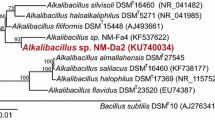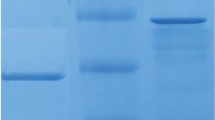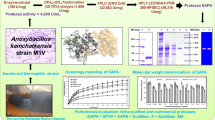Summary
Hyperthermostable proteases were characterized from five archaeobacterial species (Thermococcus celer, T. stetteri, Thermococcus strain AN 1, T. litoralis, Staphylothermus marinus) and the hyperthermophilic eubacterium Thermobacteroides proteolyticus. These proteases, which were found to be of the serine type, exhibited a preference for phenylalanine in the carboxylic side of the peptide. The enzymes from Thermococcus stetteri and T. litoralis hydrolysed most substrates (peptides) tested. All proteases were extremely thermostable and demonstrated optimal activities between 80 and 95°C. The pH optimum was either neutral (T. celer, Thermococcus strain AN 1) or alkaline. The protease of Thermobacteroides proteolyticus was optimally active at pH 9.5. Zymogram staining showed the presence of multiple protease bands for all strains investigated.
Similar content being viewed by others
References
Antranikian G (1990) Physiology and enzymology of thermophilic anaerobic bacteria degrading starch. FEMS Microbiol Rev 75:201–218.
Antranikian G, Koch R, Spreinat A (1989) German patent no. 390909096.5.
Antranikian G, Koch R, Spreinat A, Lemke K (1990) Hyperthermoactive amylases from the archaebacteria Pyrococcus woesei and Pyrococcus furiosus. In: Christiansen C, Munck L, Villadsen J (eds) Munksgaard Int. Publishers, Copenhagen. Proceedings of the 5th European Congress of iotechnology, Copenhagen, Vol. 1, pp 596–599.
Blumentals I, Robinson A, Kelly R (1990) Characterization of sodium dodecyl sulfate-resistant proteolytic activity in the hyperthermophilic archaebacterium Pyrococcus furiosus. Appl Environ Microbiol 56:1992–1998.
Bragger JM, Daniel RM, Coolbear T, Morgan HW (1989) Very stable enzymes from extremely thermophilic archaebacteria and eubacteria. Appl Microbiol Biotechnol 31:556–561.
Brown S, Costantino H, Kelly R (1990) Characterization of amylolytic enzyme activities associated with the hyperthermophilic archaebacterium Pyrococcus furiosus. Appl Environ Microbiol 56:1985–1991.
Cowan DA, Daniel R, Morgan H (1985) Thermophilic proteases: properties and potential applications. Trends Biotechnol 3:68–72.
Cowan DA, Smolenski KA, Daniel RM, Morgan HW (1987) An extremely thermostable extracellular proteinase from a strain of the archaebacterium Desulfurococcus growing at 88°C. Biochem J 247:121–133.
Eggen R, Geerling A, Watts J, Vos W de (1990a) Characterization of pyrolysin, a hyperthermoactive protease from the archaebacterium Pyrococcus furiosus. FEMS Lett 71:17–20.
Eggen R, Geerling A, Vos W de (1990b) Characterization of pyrolysin, a thermostable protease activity in the archaebacterium Pyrococcus furiosus. In: Christiansen C, Munck L, Villadsen J (eds) Munksgaard, Copenhagen. July 8–13, 1990. Proceedings of the 5th European Congress of Biotechnology, Copenhagen, p 425.
Fiala G, Stetter KO, Jannasch HW, Langworthy TA, Madon J (1986) Staphylothermus marinus sp. nov. represents a novel genus of extremely thermophilic submarine heterotrophic archaebacteria growing up to 98°C. Syst Appl Microbiol 8:106–113.
Fusek M, Lin X, Tang J (1990) Enzymic properties of thermopsin. J Biol Chem 265:1496–1501.
Heussen C, Dowdle EB (1980) Electrophoretic analysis of plasminogen activators in polyacrylamide gels containing sodium dodecyl sulfate and copolymerized substrates. Anal Biochem 102:196–202.
Hungate RE (1969) A roll tube method for cultivation of strict anaerobes. Methods Microbiol 3B:117–132.
Kelly RM, Deming JW (1988) Extremely thermophilic archaebacteria: biological and engineering considerations. Biotechnol Prog 4:47–62.
Koch R, Spreinat A, Antranikian G (1989) Characterization of amylase from Pyrococcus woesei. Abstract at the VAAM, DGHM, NVvM-Frühjarhstagung — Marburg meeting, Marburg, Forum Mikrobiologie 1–2, p 86, GIT Verlag, Darmstadt.
Koch R, Zablowski P, Spreinat A, Antranikian G (1990) Extremely thermostable amylolytic enzymes from the archaebacterium Pyrococcus furiosus. FEMS Lett 71:21–26.
Kunitz M (1947) Crystalline soybean trypsin inhibitor II. General properties. J Gen Physiol 30:291–310.
Ladzunski AM (1989) Peptidase and proteases of Escherichia coli and Salmonella typhimurium. FEMS Microbiol. Rev 63:265–276.
Lin X, Tang J (1990) Purification, characterization and gene cloning of thermopsin, a thermostable acid protease from Sulfolobus acidocaldarius. J Biol Chem 265:1490–1495.
Lowry OH, Rosebrough NJ, Farr AL, Randall JR (1951) Protein measurement with the Folin phenol reagent. J Biol Chem 193:265–275.
Miroshnichenko ML, Bonch-Osmolovskaya EA, Neuer A, Kostrikina NA, Chernych NA, Alekseev VA (1989) Thermococcus stetteri sp. nov. a new extremely thermophilic marine sulfur metabolizing archaebacterium. Syst Appl Microbiol 12:257–262.
Neuner A, Jannasch HW, Belkin S, Stetter KO (1990) Thermococcus litoralis sp. nov. a new species of extremely thermophilic marine archaebacteria. Arch Microbiol 153:205–207.
Ollivier BM, Mah RA, Ferguson TJ, Boone DR, Garcia JL, Robinson R (1985) Emendation of the genus Thermobacteroides: Thermobacteroides proteolyticus sp. nov., a proteolytic acetogen from methanogenic enrichment. Int J Syst Bacteriol 35:425–428.
Stetter KO (1986) Diversity of extremely thermophilic archaebacteria. In: Brock TD (eds) Thermophiles. Wiley, New York, pp 39–74.
Zillig W, Holz I, Janekovic D, Schäfer W, Reiter WD (1983) The archaebacterium Thermococcus celer represents a novel genus within the thermophilic branch of the archaebacteria. Syst Appl Microbiol 4:88–94.
Zillig W, Holz I, Klenk HP, Trent J, Wunderl S, Janekovic D, Imsel E, Haas B (1987) Pyrococcus woesei sp. nov., an ultra-thermophilic marine archaebacterium representing a novel order, Thermococcales. Syst Appl Microbiol 9:62–70.
Author information
Authors and Affiliations
Additional information
Offprint requests to: G. Antranikian
Rights and permissions
About this article
Cite this article
Klingeberg, M., Hashwa, F. & Antranikian, G. Properties of extremely thermostable proteases from anaerobic hyperthermophilic bacteria. Appl Microbiol Biotechnol 34, 715–719 (1991). https://doi.org/10.1007/BF00169339
Received:
Accepted:
Issue Date:
DOI: https://doi.org/10.1007/BF00169339




